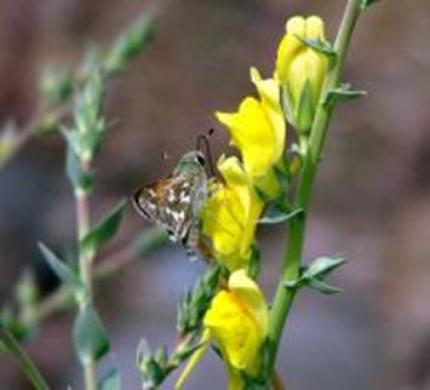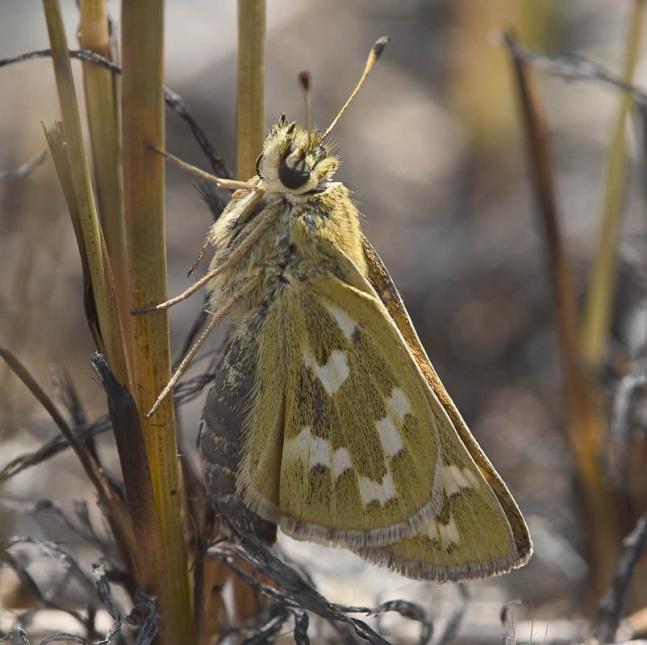Moderate
The population of the Oregon branded skipper in Washington is critical and is considered to have a declining trend. This butterfly is recognized as "Species of Greatest Conservation Need" throughout its range due to the small number of isolated populations, specialized and restricted habitat, and known threats to its habitat. Research is needed to more accurately quantify specific habitat requirements including vegetation structure, food plant size and density, and key habitat features.
Description and Range
Physical description
The Oregon branded skipper is a small butterfly; its wingspan ranges from about one inch to one and a half inches. The females are greenish in color, while the males are tawny orange. The underside of the hind wings has clear, creamy rectangular cells with leading edges and distinct markings.
Ecology and life history
In the south Puget Sound region, the Oregon branded skipper selects habitat within glacial outwash prairies dominated by short-stature native grasses and sedges, especially Roemer’s fescue (Festuca roemeri) and long-stoloned sedge (Carex inops), with open structure, and abundant bare ground (or moss/lichen). The sole extant San Juan County population uses open meadows between 1500 to 2200 feet in elevation.
Egg-laying has been observed on Roemer’s fescue and long-stoloned sedge, however, their use as larval hostplants have not been confirmed with larval feeding. The butterfly’s primary nectar plants are tansy ragwort (Tanacetum vulgare) and white-top aster (Vicia sativa).
These skippers complete a single life cycle annually (univoltine). They are sedentary butterflies and do not migrate; instead, the species inhabits sites year-round (as egg, larva, pupa and adult), typically moving within only a few hundred meters of their natal locations.

Adults emerge from their chrysalids (pupae) during July through August. Males begin emergence first, followed by females; late-season individuals are primarily or solely females. Weather influences butterfly emergence and the flight period duration, with wet or cold conditions delaying emergence.
Both males and females feed by using their long proboscis to sip floral nectar.
Male skippers seek mates by perching on low vegetation and then darting out to inspect passing butterflies. Males that detect females commence courtship behavior; when males detect another male they engage in a territory defense behavior of tight, upward spiraling flight.
Females search for egg-laying sites by slowly flying and hovering just above hostplant vegetation and then depositing single eggs.
Skipper larvae conceal themselves in silken shelters and primarily feed at night. Oregon branded skippers are members of the Hesperiinae subfamily, whose larvae create shelters formed by webbing their hostplant grass blades together, and their prepupal larvae construct strong silken shelters in hostplant grasses in which pupation occurs. The Oregon branded skipper overwinter in the egg stage.
Geographic range
Overall, the range of the Oregon branded skipper is in southwest British Columbia, Canada, and south and north Puget Sound in Washington. The butterfly occur in a few small, isolated populations. They inhabit glacial outwash prairies that have been reduced to less than three percent of historical cover. Occurrence has been documented in Pierce, San Juan, and Thurston counties.
For a map of range-distribution and conservation status of the Oregon branded skipper, check out NatureServe Explorer.
Climate vulnerability
Sensitivity to climate change
Moderate
There is no information on the physiological sensitivity of this species to climate change, however, similar to other butterflies, larval development and adult activity are likely affected by temperature and precipitation. Climate sensitivity of Oregon branded skipper is also likely affected by fire. Increasing fire frequency may help maintain glacier outwash prairie habitat by preventing conifer or shrub encroachment, as well as create bare ground patches utilized by this skipper. However, more frequent fire may facilitate invasive species establishment, which could degrade Oregon branded skipper habitat (e.g., by occupying bare ground zones).
Exposure to climate change
Moderate
- Increased temperatures
- Changes in precipitation
- Altered fire regimes
Conservation
Conservation Threats and Actions Needed
- Invasive and other problematic species
- Threat: Invasive plants, those currently here, and many yet to come in the future, out-compete native grassland species and otherwise make habitat unsuitable
- Actions Needed: Using herbicide, fire, and mechanical methods to restore native prairie; planting/seeding native prairie species
- Resource information collection needs
- Threat: Effectiveness of management is minimized by little known habitat requirements or this butterfly
- Action Needed: Conduct research to characterize the habitat selected by female for oviposition (multi-year)
- Fish and wildlife habitat loss or degradation
- Threat: Only a few, small and disjunct populations remain in the south Puget Sound region
- Action Needed: Reintroduce the butterfly at restored prairie
See the Climate vulnerability section above for more information about the threat posed by climate change to this species.
Resources
References
Crawford, R. and H. Hall. 1997. Changes in the south Puget Sound prairie landscape. Pp 11-15 in P. Dunn and K. Ewing (eds.) Ecology and Conservation of the south Puget Sound Prairie Landscape. The Nature Conservancy, Seattle, Washington . 289pp.
Hays, D., A. Potter, C. Thompson, and P. Dunn. 2000. Critical habitat components for four rare south Puget Sound butterflies. Final report to The Nature Conservancy. Washington Department of Fish and Wildlife. Olympia.
James, D. and D. Nunnallee. 2011. Life Histories of Cascadia Butterflies. Oregon State University Press, Corvallis. 447pp.
Pyle, R.M. and C.C. LaBar. 2018. Butterflies of the Pacific Northwest. Timber Press. 461 pp.
Pyle, R. 2002. The Butterflies of Cascadia. Seattle Audubon Society. Seattle, WA. 420 pp.
Pyle, R. 1989. Washington butterfly conservation status report and plan. Washington Department of Fish and Wildlife, Olympia. 216pp.
Schultz, C., E. Henry, A. Carleton, T. Hicks, R. Thomas, A. Potter, M. Collins, M. Linders, C. Fimbel, S. Black, H. Anderson, G. Diehl, S. Hamman, R. Gilbert, J. Foster, D. Hays, D. Wilderman, R. Davenport, E. Steel, N. Page, P. Lilley, J. Heron, N. Kroeker, C. Webb, and B. Reader. 2011. Conservation of prairie-oak butterflies in Oregon, Washington, and British Columbia. Northwest Science 85: 361–388
Takaoka, S., and F. Swanson. 2008. Change in extent of meadows and shrub fields in the central western Cascade Range, Oregon. The Professional Geographer 60:527-540.
